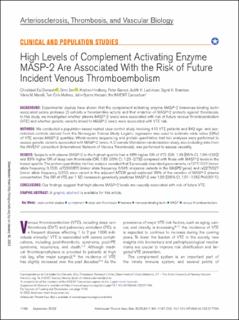| dc.contributor.author | Damoah, Christabel Esi | |
| dc.contributor.author | Snir, Omri | |
| dc.contributor.author | Hindberg, Kristian Dalsbø | |
| dc.contributor.author | Garred, Peter | |
| dc.contributor.author | Ludviksen, Judith K | |
| dc.contributor.author | Brækkan, Sigrid Kufaas | |
| dc.contributor.author | Morelli, Vania Maris | |
| dc.contributor.author | Mollnes, Tom Eirik | |
| dc.contributor.author | Hansen, John Bjarne | |
| dc.date.accessioned | 2023-02-13T08:09:21Z | |
| dc.date.available | 2023-02-13T08:09:21Z | |
| dc.date.created | 2022-11-07T14:28:35Z | |
| dc.date.issued | 2022 | |
| dc.identifier.citation | Arteriosclerosis, Thrombosis and Vascular Biology. 2022, 42 (9), 1186-1197. | en_US |
| dc.identifier.issn | 1079-5642 | |
| dc.identifier.uri | https://hdl.handle.net/11250/3050228 | |
| dc.description.abstract | Background:
Experimental studies have shown that the complement activating enzyme MASP-2 (mannose-binding lectin associated serine protease 2) exhibits a thrombin-like activity and that inhibition of MASP-2 protects against thrombosis. In this study, we investigated whether plasma MASP-2 levels were associated with risk of future venous thromboembolism (VTE) and whether genetic variants linked to MASP-2 levels were associated with VTE risk.
Methods:
We conducted a population-based nested case-control study involving 410 VTE patients and 842 age- and sex-matched controls derived from the Norwegian Tromsø Study. Logistic regression was used to estimate odds ratios (ORs) of VTE across MASP-2 quartiles. Whole-exome sequencing and protein quantitative trait loci analyses were performed to assess genetic variants associated with MASP-2 levels. A 2-sample Mendelian randomization study, also including data from the INVENT consortium (International Network of Venous Thrombosis), was performed to assess causality.
Results:
Subjects with plasma MASP-2 in the highest quartile had a 48% higher OR of VTE (OR, 1.48 [95% CI, 1.06–2.06]) and 83% higher OR of deep vein thrombosis (OR, 1.83 [95% CI, 1.23–2.73]) compared with those with MASP-2 levels in the lowest quartile. The protein quantitative trait loci analysis revealed that 3 previously described gene variants, rs12711521 (minor allele frequency, 0.153), rs72550870 (minor allele frequency, 0.045; missense variants in the MASP2 gene), and rs2275527 (minor allele frequency, 0.220; exon variant in the adjacent MTOR gene) explained 39% of the variation of MASP-2 plasma concentration. The OR of VTE per 1 SD increase in genetically predicted MASP-2 was 1.03 ([95% CI, 1.01–1.05] P=0.0011).
Conclusions:
Our findings suggest that high plasma MASP-2 levels are causally associated with risk of future VTE. | en_US |
| dc.language.iso | eng | en_US |
| dc.publisher | American Heart Association, Inc. | en_US |
| dc.title | High Levels of Complement Activating Enzyme MASP-2 Are Associated With the Risk of Future Incident Venous Thromboembolism | en_US |
| dc.title.alternative | High Levels of Complement Activating Enzyme MASP-2 Are Associated With the Risk of Future Incident Venous Thromboembolism | en_US |
| dc.type | Peer reviewed | en_US |
| dc.type | Journal article | en_US |
| dc.description.version | publishedVersion | en_US |
| dc.source.pagenumber | 1186-1197 | en_US |
| dc.source.volume | 42 | en_US |
| dc.source.journal | Arteriosclerosis, Thrombosis and Vascular Biology | en_US |
| dc.source.issue | 9 | en_US |
| dc.identifier.doi | 10.1161/ATVBAHA.122.317746 | |
| dc.identifier.cristin | 2070089 | |
| dc.relation.project | Norges forskningsråd: 223255 | en_US |
| cristin.ispublished | true | |
| cristin.fulltext | original | |
| cristin.qualitycode | 2 | |
